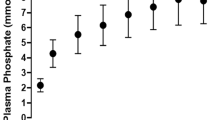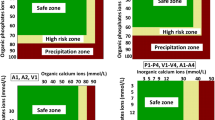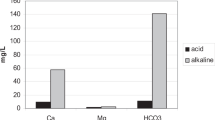Abstract
IN previous investigations of small intestinal calcium metabolism1 it has been assumed that calcium in the lumen of the small bowel is entirely in solution. We examined the hypothesis that calcium exists in more than one phase, and investigated (a) the calcium composition of endogenous intestinal secretions, and (b) the calcium and phosphate content in the lumen 30 min after a dilute calcium solution had been introduced into closed segments of small intestine. We prepared two adjacent jejunal and two adjacent ileal segments in situ in seventeen fasted, anaesthetized dogs; each segment was approximately 20 cm long and contained two arcades of mesenteric vessels. The jejunal segments commenced 16 cm distal to the ligament of Treitz and the ileal segments ended 10 cm proximal to the ileo-caecal junction. We prepared the segments individually by tying 5 mm plastic cannulae, fitted with plugs, into each end. They were thoroughly flushed with saline at 37° C, and when the effluent was clear were flushed with air. When all were prepared, the four segments were flushed as quickly as possible with 200 ml. of saline followed by air. In five dogs no solution was introduced, the “empty” segments were left in situ for 1 h and the endogenous secretion was collected by washing with 25 ml. of 5 per cent mannitol. In twelve dogs we immediately introduced 10 ml. of a solution containing 1 mg of calcium (as calcium chloride) and 100 mg of inulin. After 30 min the luminal contents were collected by drainage and analysed for calcium (using an Eppendorf flame photometer), phosphate2, and inulin3. All samples contained a small proportion of precipitate, and they were centrifuged as soon as they were obtained and the supernatant was analysed immediately for calcium and phosphate. The remainder of the sample was acidified with 0.2 ml. of concentrated hydrochloric acid and the mixed sample was reanalysed immediately for calcium and phosphate. This latter result was corrected for volume effects (acid added and samples removed), and concentration was calculated for the original volume. The quantity of calcium secreted into “empty” segments was calculated directly from the concentration of calcium in the washings and the wash volumes. When the calcium solution was introduced it was necessary to correct sample volume, for recovery by drainage is incomplete. Inulin was virtually unabsorbed during a 30 min period. The ratio of initial to final inulin concentration multiplied by the initial volume therefore gives total sample volume. This corrected volume was used to calculate total calcium and phosphate content of the segments.
This is a preview of subscription content, access via your institution
Access options
Subscribe to this journal
Receive 51 print issues and online access
$199.00 per year
only $3.90 per issue
Buy this article
- Purchase on Springer Link
- Instant access to full article PDF
Prices may be subject to local taxes which are calculated during checkout
Similar content being viewed by others
References
In The Transfer of Calcium and Strontium Across Biological Membranes (edit. by Wasserman, R. H.) (Academic Press, New York and London, 1963).
Fiske, C. H., and Subbarow, Y., J. Biol. Chem., 66, 375 (1925).
Roe, J. H., Epstein, J. H., and Goldstein, N. P., J. Biol. Chem., 178, 839 (1949).
Author information
Authors and Affiliations
Rights and permissions
About this article
Cite this article
SCHEDL, H., OSBALDISTON, G. & MILLS, I. Role of Intraluminal Precipitation in Secretion of Small Intestinal Calcium and Phosphate in the Dog. Nature 215, 198–199 (1967). https://doi.org/10.1038/215198b0
Received:
Issue Date:
DOI: https://doi.org/10.1038/215198b0
This article is cited by
Comments
By submitting a comment you agree to abide by our Terms and Community Guidelines. If you find something abusive or that does not comply with our terms or guidelines please flag it as inappropriate.



